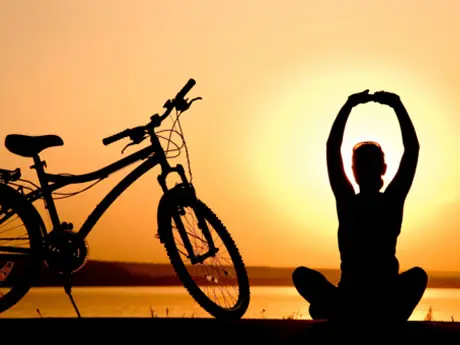
The cycling position is not natural. Our spine is designed to have three balanced curves in the shape of an "S". On the bike, our spine loses its shape as the body rounds forward from the tailbone to the shoulders when we reach between the saddle and handlebars. In this position, the pelvis, at the base of the spine, deviates from a neutral posture. The pelvis can tilt too far forward, pulling the lumbar vertebrae in the lower back out of alignment. This can cause pain and lead to lower back disorders.
When dismounting your bike after a long ride, you've probably noticed stiffness in your low back that makes it difficult to quickly come up to a full upright posture. What you're feeling is the tightness in your hip flexors that is not allowing your pelvis to rotate back to a neutral position. Your muscles hold you in a cycling posture even when you're no longer on the bike. Unless this tension is released regularly, your back pain will progress and your posture will deteriorate.
More: Exercises to Treat Shoulder and Neck Pain From Cycling
Preventing back pain depends on keeping the hip flexors lengthened and strong. Perform these exercises regularly in the order presented to maintain hip flexor health and to keep pedaling pain free.
Posture Exercise #1: Static Back
Lie on your back with your legs up on a chair, your hips and knees bent at a 90-degree angle. Place your arms out to your sides at a 45-degree angle with the palms up. Breathe deeply into your diaphragm, expanding the air forward and into your sides. Hold this position for five minutes. The goal is to allow enough time for your entire backside, from your shoulder blades to your pelvis, to sink into the floor with equal contact from left to right.This passive exercise allows all the muscles in the torso to relax and realign into a neutral position. Taking the body out of gravity with support from the floor, the muscles no longer have to work to hold you up and can lengthen and release. The 90-degree position with the legs resets the hips within the pelvic girdle and helps reduce pelvic rotation that may have developed from an imbalanced pedal stroke. The floor acts as a template for correct joint posture from the pelvis to head. Deep-diaphragm breathing enhances the muscles ability to lengthen.
More: How to Avoid Lower Back Pain While Cycling
Posture Exercise #2: Knee Drops
Lie on your back with your knees bent at 90 degrees and with your feet straight, placed wider than hip width. If using a yoga mat, align the inside edge of your feet with the edge of the mat on both sides.Place your arms by your sides at a 45-degree angle with the palms up. Slowly drop both knees to your right allowing your left hip to come off the floor and lower back to twist. Rotate your head to the left, touching your ear to the floor. Hold the position for 1 to 2 seconds and then switch, bringing the knees to the left as the head rotates right. Keep your upper body relaxed and breath from your diaphragm as you rotate. Don't force or bounce during the stretch. Repeat 20 times on each side.
- 1
- of
- 2
About the Author









Discuss This Article